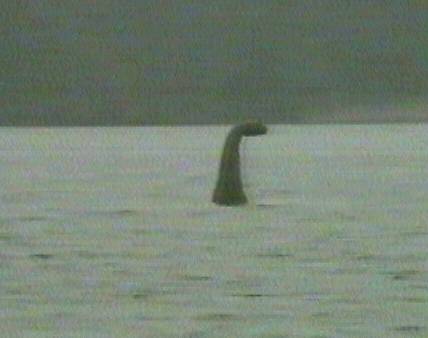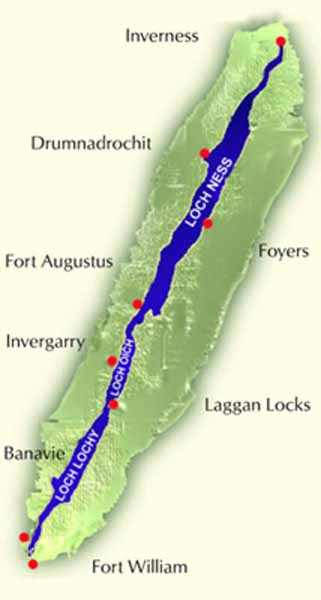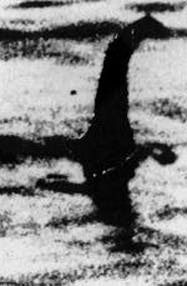| |
Unexplained Mysteries of Loch Ness Monster |
|
 |
|
The Loch Ness Monster, sometimes called "Nessie" or "Ness" (Scottish Gaelic: Niseag) is a creature or group of creatures said to live in Loch Ness, a deep freshwater loch (lake) near the city of Inverness in northern Scotland. Nessie is generally categorized as a lake monster.
Along with Bigfoot Nessie is one of the best-known mysteries in cryptozoology though most mainstream scientists and other experts find current evidence supporting Nessie unpersuasive and regard such reports as hoaxes or misidentification of mundane creatures.
Carvings of this unidentified animal, made by the ancient inhabitants of the Scottish Highlands some 1,500 years ago, are the earliest evidence that Loch Ness harbors a strange aquatic creature. This resembles the stone carvings of the Chupacabra.
Rumors of a monster, or animal, living in the loch are claimed by believers to have been known for several centuries, though others have questioned the accuracy and reliability of such tales, which were generally unknown before the 1960s. The earliest claimed reference is taken from the Life of St. Columba by Adamnan. It describes how in 565 Columba saved the life of a Pict, who was being supposedly attacked by the monster.
Critics have questioned the reliability of the source, noting a different story in which Columba slays a wild boar by the power of his voice alone. They also point out that the event is said to have occurred on the River Ness, not in the Loch, and that Adamnan reports Columba encountering and conquering assorted "monsters", at various places in Scotland, throughout his "life". Additionally, they point out that the Loch Ness monster has no other reported instance of attacking anyone, and in fact is generally portrayed as shy and people-avoidant.
The first modern sighting occurred on May 2, 1933. The newspaper Inverness Courier carried a story of Mr. and Mrs. John Mackay, who reportedly saw "an enormous animal rolling and plunging on the surface." The report of the "monster" (a title chosen by the editor of the Courier) became a media sensation with London papers sending reporters to Scotland and a circus, even offering a reward of 20,000 pounds for capture of the monster. Later that year, A.H. Palmer, who allegedly witnessed Nessie on August 11, 1933, at 7 a.m., described the creature as having its head, which they saw from the front, set low in the water. Its mouth, which had a width of between twelve and eighteen inches (30-45 cm), was opening and closing; its maximum mouth aperture was estimated to be about six inches (15 cm).
The modern preoccupation with the Loch Ness Monster was aroused by a photograph allegedly taken by surgeon R.K. Wilson on April 19, 1934, which seemed to show a large creature with a long neck gliding through the water. Decades later, on March 12, 1994, Marmaduke Wetherell claimed to have faked the photo after being hired by the Daily Mail to track down Nessie (the photo had by that time been printed worldwide as "absolute evidence"). Wetherell also stated that Wilson did not take the photo, and his name was only used to give added credibility to the photo.
Regardless of whether anything is actually in the loch, the Loch Ness Monster has some significance for the local economy. Dozens of hotels, boating tour operators, and merchants of stuffed animals and related trinkets owe part of their livelihood to this monster, although people visit the loch for many reasons other than to see the monster. Hence, the legend is likely to endure for quite some time.
In 1962 The Loch Ness Investigation Bureau was formed to act as a research organization and clearing house for information about the creature. In the beginning it only conducted research for a few week in the year, but by 1964 they established a more permanent presence around the Loch. Eventually the Bureau established camera stations with both still and cinema cameras with telephoto lenses. They had vans which served as mobile camera stations, and underwater listening devises. Searches were conducted using hot-air-balloons and infrared night time cameras, sonar scanners and submarines. A great deal of information was discovered about the Loch, but they have yet to produce any concrete evidence of a monster.

Loch Ness is located in the North of Scotland and is one of a series of interlinked lochs which run along the Great Glen. The Great Glen is a distinctive incision which runs across the country and represents a large geological fault zone. The interlinking was completed in the 19th century following the completion of the Caledonian Canal.
The Great Glen is more than 700 ft (213 m) deep and ice free. It is fed by the Oich and other streams and drained by the Ness to the Moray Firth. It forms part of the Caledonian Canal. By volume, Loch Ness is the largest freshwater lake in Great Britain.
Since Dec., 1933, when newspapers published accounts of a 'monster,' 40 to 50 ft (12-15 m) long, said to have been seen in the loch, there have been alleged sightings.

Most of the Nessie witnesses describe something with two humps, a tail, and a snakelike head. A V-shaped was often mentioned, as well as a gaping red mouth and horns or antennae on the top of the creature's head. Nessie's movements have been studied, and the films and photos analyzed to determine what Nessie might be, if she exists.
Loch Ness Theories
Most accounts of Nessie's appearance, including historical ones, indicate a creature resembling the long-extinct plesiosaur. Actual fossil evidence for this Mesozoic creature shows it to have been physically large, with a long neck and tiny head, with flippers for propulsion. The alleged connection of this creature with the Loch Ness monster has made it a popular topic in the field of cryptozoology.
However, most scientists suggest the idea that the Loch Ness Monster is a remnant of the Mesozoic era is highly unlikely; there would need to be a breeding colony of such creatures for there to have been any long-term survival, and coupled with the fact that plesiosaurs needed to surface to breathe, this would result in far more frequent sightings than have actually been reported (some animals, such as crocodiles, that need to breathe air intermittently, can stay underwater for extended periods of time by remaining still and conserving its oxygen supply).
Many biologists also argue Loch Ness is not large or productive enough to support even a small family of these creatures. Moreover, the loch was created as the result of geologically recent glaciation and was frozen solid during recent ice-ages.
Other sightings, however, do not fit the plesiosaur description or even a water-bound creature: In April 1923, Alfred Cruickshank claimed to have seen a creature 3 m to 3.5 m long, with an arched back and four elephant-like feet cross the road before him as he was driving. Other sightings report creatures more similar to camels or horses.
Theories as to the exact nature of the Loch Ness Monster sightings are varied: pareidolia or misidentification of seals, fish, logs, mirages, seiches, and light distortion, crossing of boat wakes, or unusual wave patterns.
Very large sturgeon have been found in inland streams close to Loch Ness, and due to sturgeons' size and unusual appearance, one could easily be mistaken for a monster by someone not familiar with it.

A recent theory postulates that the "monster" is actually nothing more than bubbling and disruptions in the water caused by minor volcanic activity at the bottom of the loch. This latter argument is supported to a minor degree by a correlation between tectonic motion and reported sightings.
Some researchers, notably John Keel, F.W. Holiday, A. Winchester Beebe (otherwise known as the Buffalo musician Nikki Christmas), and Jon-Erik Beckjord, postulate that there are no anomalous physical creatures within the loch. Because of the complete absence of physical evidence, these researchers argue that many of the reported sightings can be attributed to hoaxes or misidentification of conventional creatures and objects. They also argue that a small residue of reported Loch sightings could be paranormal, or supernatural in nature, i.e., having a temporal semi-physical construction, similar to other anomalous phenomena such as Bigfoot and UFOs.
Evidence for Loch Ness
Evidence for
Some have argued a history of "monster" sightings in the loch is circumstantial evidence supporting the creature's existence. Note that these notions have been challenged.
In the early 1970s, a group led by American patent lawyer Robert Rines obtained some underwater photographs. One was a vague image, perhaps of a rhomboid flipper (others have argued the object could be air bubbles or a fish fin).
On the basis of this photograph, Sir Peter Scott, one of Britain's best-known naturalists, announced in 1975 that the scientific name of the monster would henceforth be Nessiteras rhombopteryx1 (Greek for "The Ness monster with diamond-shaped fin). This would enable Nessie to be added to a British register of officially protected wildlife. It has been noted by London newspapers that Nessiteras rhombopteryx is an anagram of "monster hoax by Sir Peter S." Monster-hunter Dr Robert Rines replied that the letters could also be rearranged to spell "Yes, both pix are monsters--R."
The underwater photos were obtained by painstakingly scouring the loch's depths with sonar, over the course of days, for unusual underwater activity. An underwater camera with an affixed, high-powered light (necessary for penetrating Loch Ness' famed murk) was then deployed to record images from below the surface. Several of the resulting photographs, despite their obviously murky quality, indeed seem to show an animal quite resembling a plesiosaur in various positions and lightings. A few close-ups of what is alleged to be the creature's diamond-shaped fin were also taken, in different positions, indicating movement.
Evidence against
Perhaps typical of the many unsatisfactory "facts" about Nessie is the alleged sighting of October 1871. In this incident, "D. Mackenzie" supposedly described seeing something that moved slowly before moving off at a faster speed. People who saw "the monster" were said to describe it as having a hump (sometimes more than one) that looked like an upturned boat. However, although this story has been repeated in several places, no original 1871 source has been cited, casting doubt on the report.
This famed "Surgeon's Photo" was confirmed a hoax, based on the deathbed confessions of Chris Spurling, son-in-law of Marmaduke Wetherell. Spurling claimed the photo, which inspired much popular interest in the monster, was actually a staged photograph of clay attached to a toy submarine. Wetherell, a big game hunter, had been tricked into searching for an imaginary monster around the loch based on evidence which turned out to be the result of children's prank.
He was publicly ridiculed in the Daily Mail, the journal which employed him. To get revenge, Marmaduke Wetherell set this hoax up, with the help of Chris Spurling (his son-in-law as mentioned), who was a specialist in sculpture, Ian Marmaduke (his son), who bought the material for the fake Nessie, and Maurice Chambers (an insurance agent), who was to call and ask Robert Wilson (a surgeon) to show the pictures. Well before Spurling's claims, however, others had argued the photo was that of an otter or a diving bird. Note that there are in fact two "Surgeon's Photos," which depict slightly different poses, leading some to argue the photos are evidence against a hoax. Also interesting to point out is that the surgeon who was credited for taking the photo never claimed he hadn't taken it either.

Submit News/Videos/Links |
Discuss article |
Article Link
|
More unsolved mysteries on Unexplained Mysteries
|





![]()